The Wangkatjungka Remote School Mentors Project – Part 1
The Principal’s Story – Keith Spencer

In 2009 a project at Wangkatjungka Remote Community School brought the teenagers and elders together. The project boosted school attendance to unheard of levels as well as creating an exciting event at Japingka Gallery. Here is the story of that project told by Keith Spencer, Principal of Wangkatjungka Remote School at that time.
Quick links: Part 1 | Part 2 | Part 3
Where is Wangkatjungka?
They call it the Central Kimberley region. It’s halfway between Broome and Kununurra. Wangkatjungka is about 100km from Fitzroy Crossing.
How many people live at Wangkatjungka itself?
That’s a hard one too because some people can move around. They might move for cultural reasons or employment or a family issue. The population is usually somewhere between 300 to 400.
How remote is it? Is it hard to get to?
Yes, it can be in the wet season. There’s 23 km of dirt that can be challenging. Once you get past that you’re on bitumen through to Fitzroy Crossing or Halls Creek.
Can you describe what the Wangkatjungka Remote School was like?
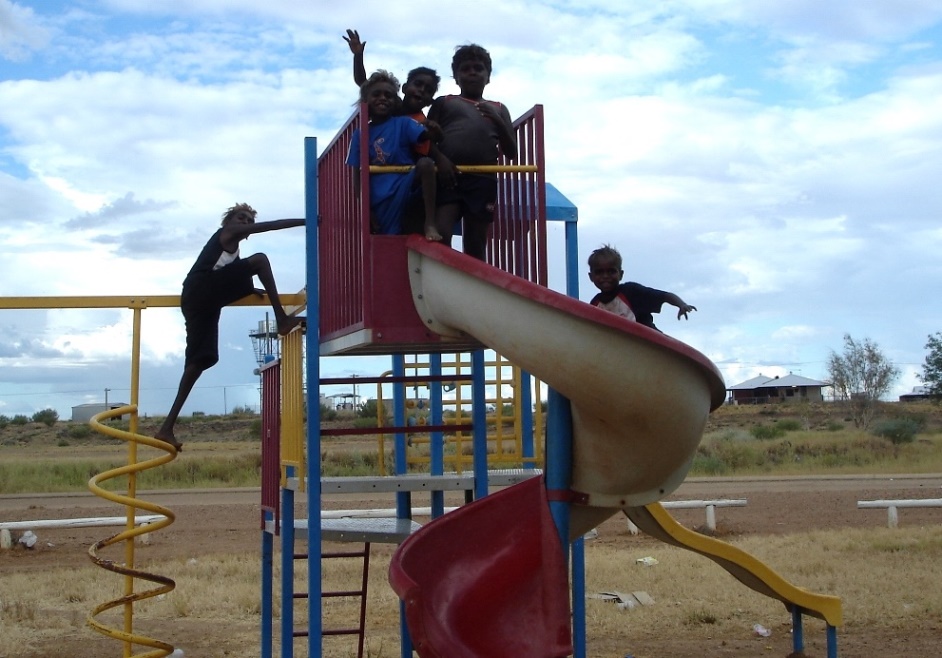
It’s an interesting community. I actually loved it. One thing I found was that the people wanted to be involved with the school. They made sure that they let me know that when I arrived there. I was very keen to engage with them in any way shape or form.
One of our managers from the Regional Office, Edie Wright, was fantastic. She’d been a Principal at that same school. She was helpful nurturing a relationship between myself and the community.
It’s a very slow process. People have got to see you and speak to you and get to know you in a slow way. Slowly the trust develops on both sides. That’s how it evolved. I was able to get a lot more Aboriginal people, local people, working in the school. We were able to get a little bit of extra funding and things like that.
How did the art project come about?
My wife had an art gallery many years ago in country Victoria. She’s a bit of an artist herself even though she says she’s not. We had a few high school girls who wanted to do a project. We asked them if they wanted to paint on some concrete between what was the Home Economics room and the Grade 6 room. That concrete had cracked so they thought each student could paint a set area. They’d paint the cracks black and then they’d have their own area to decorate.
The girls didn’t know what to paint. They told us “we’ve never been taught by our family. We want to know, but we just paint things like we see on telly and in the magazines.” Then Katie, my wife, developed an idea of getting the community involved.

She spoke to David Wroth. David and Katie bounced around this idea with one of the teachers and myself. The aim was to engage those high school girls. Many of them wouldn’t come to school. We had a number of students whose attendance was below 20%, so you’re lucky to get them 1 day a week. David, the teacher and Katie worked closely together to organise the project. David found the mentors because he’d already worked with some of the elders in the community.
The older women came in as mentors for the young girls. They worked with them couple of days a week. It soon became a bit of a challenge. The women saw the young girls were very keen and quite good painters. Each elder had a different style of painting and the young girls would also paint in that style. The young girls were so talented it actually lifted the quality of work coming from the elders.
The project became a real focus for the those girls to get to school. They’d do their work in the morning. This might be some English or some numeracy and perhaps a little bit of computer work. It got them engaged in the school program, and that’s how it evolved.
We felt very fortunate when David offered to organise the exhibition with the children’s work. It was very successful. David managed the whole process of those students going to Perth.
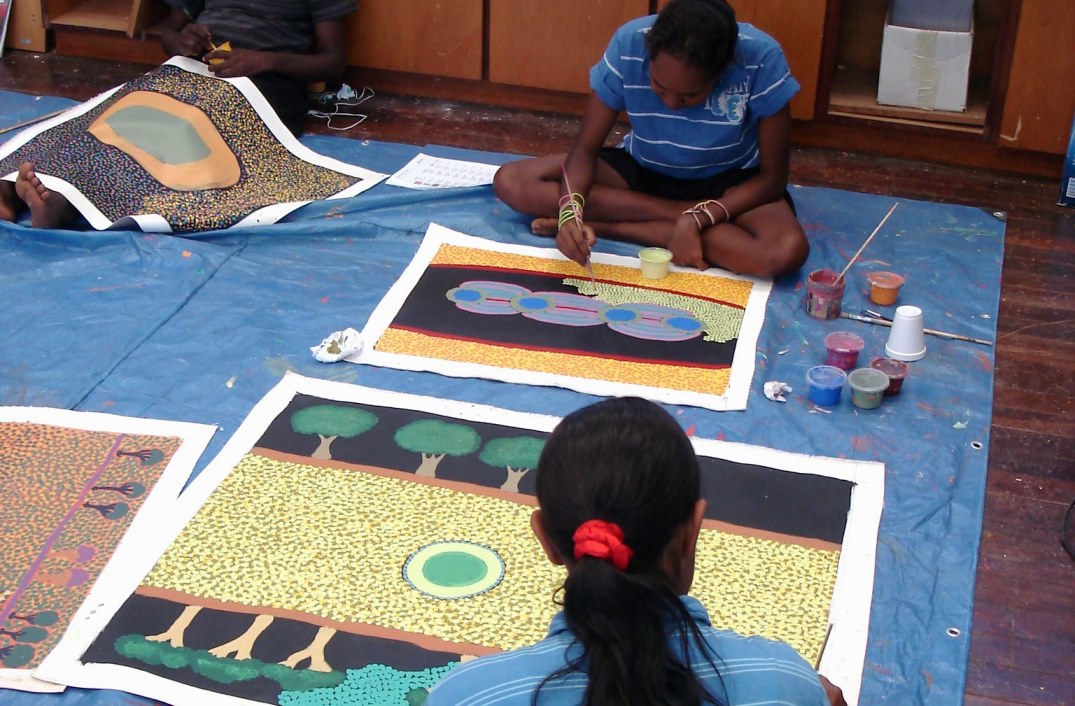
When you set out, what were the outcomes that you were looking for?
To be honest it was purely attendance at first. I would use any carrot I possibly could to get those children through the door. These were young girls. They ranged in age from of 12 to 16.
What were the approvals and sign offs that you needed to organise?
It is the Principal’s responsibility to go through every aspect of it. I negotiate it with parents and community for their approval firstly. Then it’s through the regional office for me to get the travel approved. Of course, because there was travel it falls very much back on the Principal.
It’s basically the Principal who ensures that everything is safe for all students. That’s the number one priority. David was absolutely fantastic and very generous with the marketing of the students’ exhibition. He spoke to the students about that so it was very clear. He was always available to talk to parents and elders.
We also took two elders down, Nada and Penny, down to the exhibition. Edie Wright opened the exhibition. She was the manager of Aboriginal Education.
It is the Principal’s responsibility is to ensure that it is all above board and safe for the children.
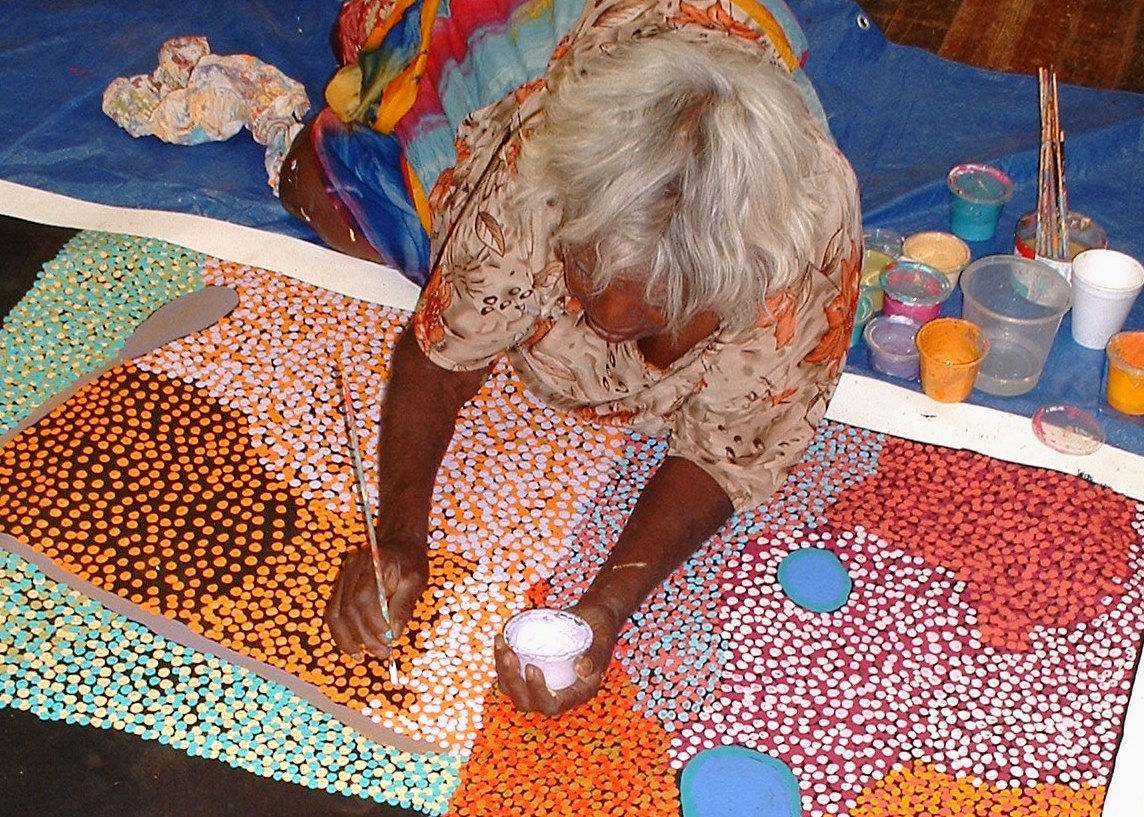
What were the organisations that supported the project? What support did they give?
To me it was Japingka Gallery. It was only that one organisation and the school. It’s very hard to get sponsorship for somewhere like Wangkatjungka.
For me it was breaking new ground. I had discussions with Regional Director Bill Mann. He was very supportive of it. He understood where we were coming from. We wanted a carrot to get those girls through the gate over longer periods of time.
I can’t remember the exact figure but we went from under 20% for some of those girls to over 80%. We were able to keep the girls in the system a bit. The benefits of doing the artwork was that they were able to do literacy and numeracy with them earlier in the day.
How did the project run day to day?
Two teachers Stephen Cox (Percy)and Jody Harrington ran a lot of it. Both of those teachers traveled to Perth with the students. Jody had taught at the school for about 5 years, so she knew these young girls well.
We did the painting in the woodwork room, or manual arts room. They had air conditioning in there and the older mentors liked that. It was a nice, cool, clean place for them. We always offered them morning tea. They just wanted a kettle down there and they’d have their cups of tea. We’d take them down bikkies and they’d have lunch with the girls if they were there.
The girls were respectful of the elders. Even when they’re out bush. If the older women ask for something the young girls feel it’s their responsibility to do it. If the elders want water, they would go and get it. The girls observed those same cultural rituals at the school. They understood their role in the structure of their society.
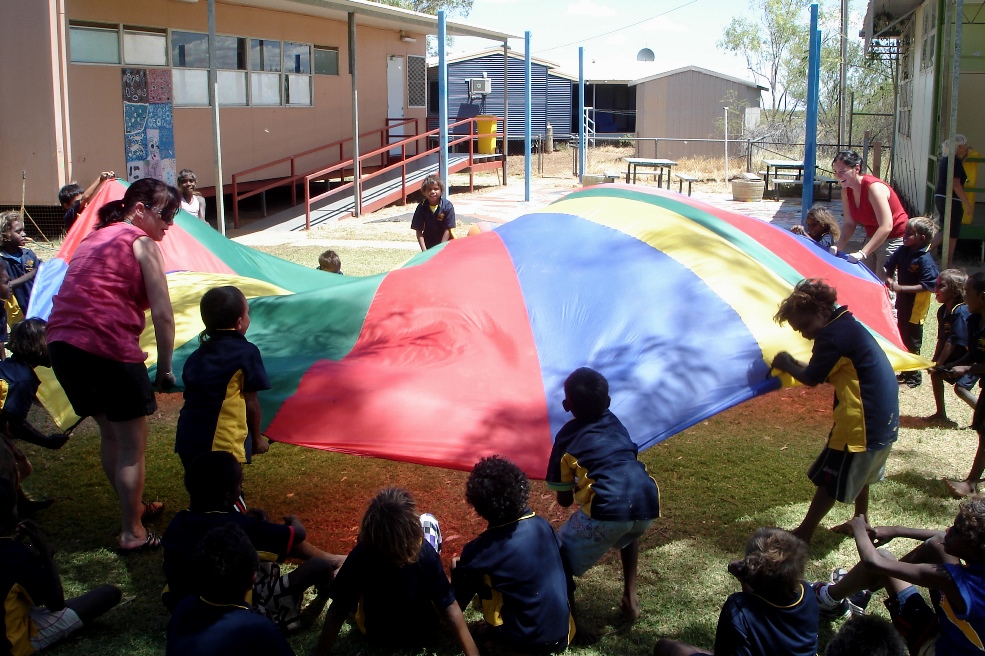
What impact did you see this project have on the students while they were making the art?
Incredible improvement in confidence and self worth. They went from thinking they couldn’t do things to having a go at their literacy and numeracy. All of their schoolwork increased out of sight. The attitude towards their work changed because they knew they were achieving in another area. Working in the artistic area made a big difference.
Each girl was working with an elder who may well have been family. They would develop their artwork in that style. The girls knew that the mentors were held in high regard. They saw they had approval from the mentors to do their art in that style. They could see that something important was being carried forward.
There was a noticable increase in self worth and ability to have a go. Often Aboriginal children and teenagers shut down and say, “No, I’d be ashamed doing that.” That didn’t occur after they gained some confidence with painting.
We had six or seven girls in the program at one stage. The group did a large piece which they gave to us when we left the school. When one of the girls couldn’t finish her area, they all pitched in and finished it for her. They got on well as a team. There wasn’t the tension you sometimes see with teenage girls. They just seemed to be a great bunch of kids.
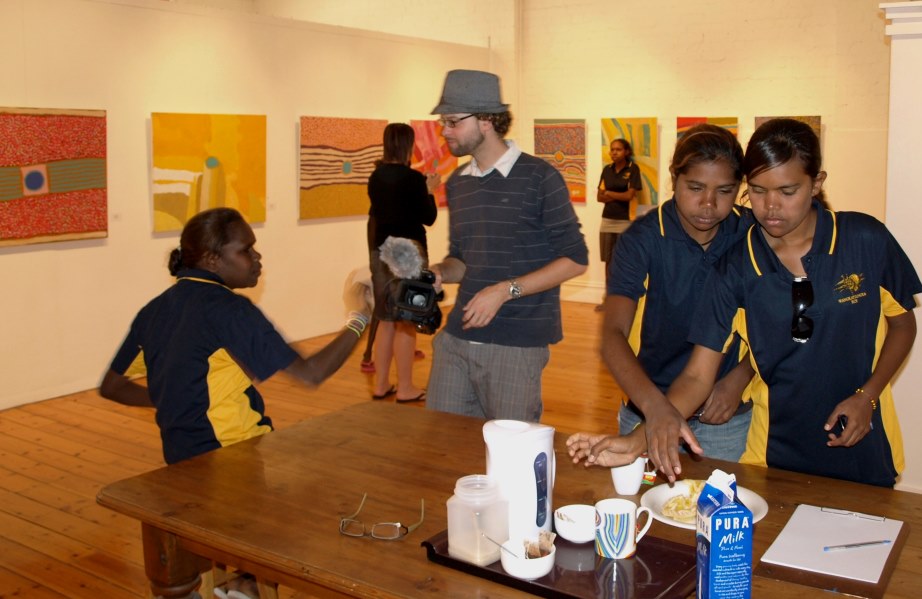
What was it like bringing them to the exhibition?
A group of teachers and assistants came down with the girls and two of the mentors. They were stunned. Katie and I went down for the last couple of days. I think we got their Wednesday night and the exhibition opened on the Friday.
They took the two elders to the aquarium when the girls went. The mentors saw barra in the aquarium. Their eyes lit up, they wanted them for supper.
There were some interesting relationships between the elders and the young ones. We’d arranged for the young girls to go to the water park and places like that. The elders wanted to go too, because they didn’t want to miss out on anything. They wanted to be part of everything that went on.

What do you think made the project so successful?
David. Purely and simply. His manner and the way he negotiated with the school and with the mentors. It was also the way he spoke to the mentors and how he explained things to them. The way he worked in with our teachers and even myself. It was fantastic.
David had a profile in the community. He’s had an ongoing relationship with the Wangkatjungka artists over a number of years. For me it was all totally positive. From what I saw in the relationship that he had with the elders and the students. That was just brilliant.
You sometimes hear communities saying they get ripped off by galleries. But I certainly wouldn’t say that about David and our experience with Japingka. He was open and honest with the girls. Everything that was done for that exhibition was done professionally and beautifully. Everything was first class.
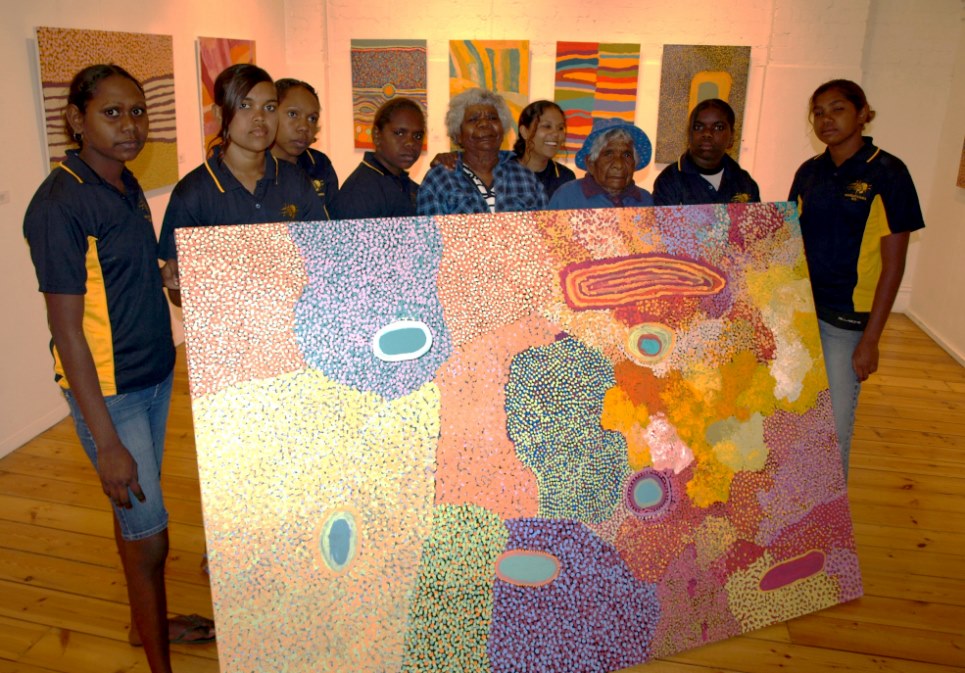
What advice would you have for Principals who might be thinking about doing something similar with their community?
You’ve got to know your community and who to speak to. This means doing a bit of research yourself. You need to find the artists and talk to people around the school. It might be the art teacher in the school, but not necessarily. There might be teachers and AIEOs who have an ability to encourage the students.
Projects like these don’t just have to be initiated by community. It could come from within the school as well to develop those students and work with the gallery. Because the gallery is what really made it. It was brilliant the way they put it together.
As a project to assist with higher levels of attendance you’d recommend it?
Oh, absolutely, but we were fortunate too. Don’t forget we had quality artists out there. We had a quality person in David Wroth who actually worked with and assisted us. The end goal, the carrot at the end was enormous. They all got a trip to Perth, the school paid for that.
There is a cost factor, but sometimes it goes beyond the dollar. It’s actually more about what the benefit is for the child and their future.
Read more:
